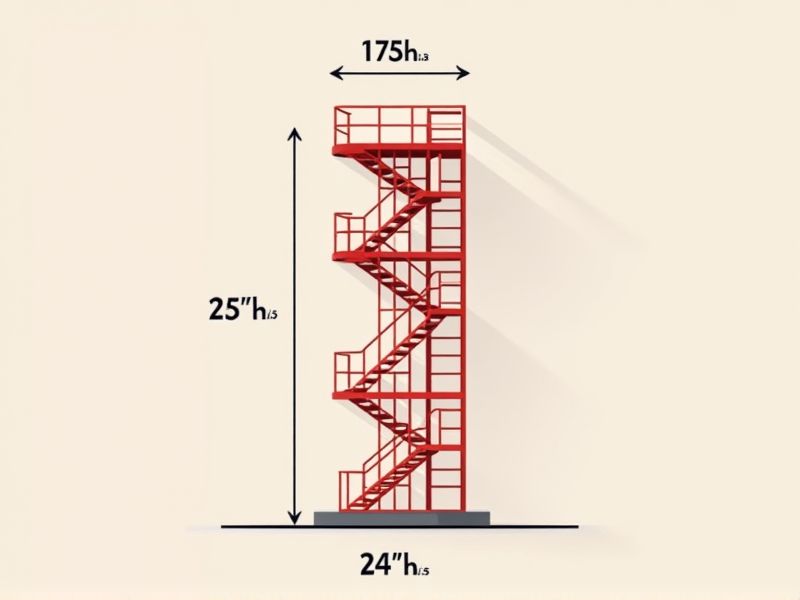
When planning a fire escape, adhering to standard dimensions is crucial to ensure safety and regulatory compliance. Generally, fire escape stairs should have a minimum width of 22 inches (about 56 centimeters) to allow safe passage. The rise of each step typically should not exceed 8 inches (20 centimeters), with a minimum tread depth of 9 inches (23 centimeters) for secure footing. Always check your local building codes, as requirements can vary, and consulting a professional can help ensure your fire escape meets all necessary safety standards.
Minimum Width: 36 Inches
Fire escape standards dictate a minimum width of 36 inches to ensure safe and efficient egress during emergencies. This clearance allows individuals to pass through quickly, reducing congestion and facilitating rapid evacuation from buildings. Compliance with this width helps meet safety regulations and enhances the overall emergency response quality. Maintaining this standard is crucial for protecting lives and improving safety protocols in urban planning and building design.
Tread Depth: 9 Inches
The standard for fire escape stairs mandates a minimum tread depth of 9 inches, ensuring robust safety and adequate footing during emergencies. This measurement supports swift evacuation, allowing individuals to securely place their feet while descending. Stairways with proper tread depth mitigate the risk of slips and falls, enhancing overall safety in high-traffic situations. Adhering to these guidelines is crucial for compliance with fire safety regulations and effective emergency preparedness in buildings.
Riser Height: 8 Inches
The standard riser height for fire escapes is typically set at 8 inches, ensuring accessible and safe egress in emergencies. This measurement allows for a comfortable climb, minimizing the risk of tripping or falling during a quick evacuation. By adhering to this standard, buildings enhance the overall safety of occupants, particularly in multi-story structures. Ensuring that your fire escape meets this riser height guideline can significantly contribute to effective emergency preparedness and compliance with safety regulations.
Landing Width: Equal To Width Of Stairs
The National Fire Protection Association (NFPA) dictates that the landing width for fire escapes should match the width of the stairs, ensuring a safe and efficient exit during emergencies. A typical stair width should be no less than 44 inches for occupancy loads greater than 50 people, promoting ease of movement. For buildings with limited occupancy, the minimum landing width can be 36 inches, but it's crucial to adhere to local codes and regulations. Your understanding of these standards can significantly enhance safety and compliance in fire escape design.
Vertical Clearance: 7 Feet
The standard for fire escape vertical clearance requires a minimum height of 7 feet to ensure safe passage during an emergency. This specification applies to all areas along the escape route, providing adequate space for individuals to evacuate without obstruction. Maintaining this clearance not only enhances safety but also complies with building codes, reducing liabilities for property owners. Regular inspections can help ensure that fire escapes meet this crucial height requirement, ensuring your safety during a fire emergency.
Handrail Height: 34 To 38 Inches
The standard height for handrails in fire escape systems is critically set between 34 to 38 inches. This specific range promotes safety by ensuring adequate support and fall prevention for individuals using the escape route during emergencies. Compliance with this regulation is essential for structures to meet safety codes and provide effective evacuation solutions. You should verify that your fire escape handrail height adheres to these guidelines to enhance overall safety during emergencies.
Maximum Stair Rise: 12 Feet Between Landings
The standard for fire escape design mandates a maximum stair rise of 12 feet between landings, ensuring safe and efficient egress during emergencies. This guideline is crucial as it helps to reduce fatigue and maintain compliance with safety codes, facilitating a quicker evacuation. Adequate landings also provide a resting place, enhancing occupant safety. By adhering to these regulations, you contribute to safer building environments for all occupants.
Step Uniformity: Consistent Dimensions
Standard fire escape designs emphasize step uniformity, ensuring consistent dimensions across stair treads and risers. The ideal tread depth is typically around 11 inches, while risers should be no higher than 7 inches to facilitate safe and easy navigation during emergencies. You should verify that all steps adhere to these specifications, as variations can lead to accidents or increased evacuation time. Maintaining proper illumination and handrail support alongside uniform step dimensions significantly enhances overall safety in fire escape routes.
Load Capacity: 100 Pounds Per Square Foot
The standard for fire escape load capacity is set at 100 pounds per square foot, ensuring a safe evacuation route during emergencies. This load capacity accounts for the weight of multiple individuals who may be using the escape simultaneously, enhancing overall safety. Compliance with this standard is critical for both residential and commercial buildings to meet safety regulations and prevent structural failure. When assessing your fire escape system, always verify that it adheres to this load capacity requirement for maximum reliability.
Door Width: Minimum 32 Inches
The standard for fire escape doors mandates a minimum width of 32 inches to ensure safe and efficient evacuation during emergencies. This dimension allows for the quick passage of individuals, including those with mobility aids, thereby reducing the risk of bottleneck situations. Compliance with this regulation is critical to enhancing safety in public and commercial buildings, where large numbers of occupants may need to exit swiftly. Always prioritize this measurement in your building plans to meet fire safety codes and protect lives.
